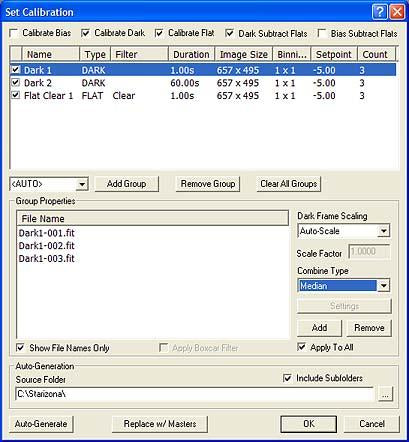
Calibrating Images
In the Image Processing Basics section on Calibrating Images we discussed only one type of image calibration -- dark subtraction. This is the most important calibration step, but not the only one that can be performed. Other techniques include using flat fields and bias frames to calibrate a raw CCD image.
Flat Fields
Flat fields are used to remove variations in the brightness of pixels across the CCD chip. These variations are usually caused either by variances in sensitivity from pixel to pixel, or by the telescope optics. Main causes due to the telescope are vignetting and out-of-focus dust on one of the lenses in the optical system.
Below is an uncalibrated image of the Whirlpool Galaxy.

Below is a flat field taken using the identical imaging system.

Select the proper flat field file of files in the Calibrate window as shown below. Notice that multiple dark frames have also been selected as you will want to perform a dark subtract as well. (See the Image Processing Basics section on Calibrating Images for more details on dark subtracting an image.) In this case, using several calibration images reduces the noise in those images.

Above: Calibration window set up to median combine three darks and three flats. The flats will also be dark subtracted.
Calibrating the image should result in an image similar to the one below. Note that the noise (white specks) in the image have been removed by the dark frame, and that the uneven background illumination and dust halos have been eliminated by the flat field.

Above: The calibrated image of M51. Combining the images would be the next step to remove the grainy appearance.
Bias Frames
As pixels are read out of a CCD camera there is a slight offset, or bias, that occurs. This offset varies from pixel to pixel and can cause noise in the image. A bias frame is used to subtract this offset.
A bias frame is an exposure of zero duration. When this exposure is read out the only information contained is the bias values and a slight amount of read noise from the process of transferring the charge out of the CCD. Bias is inherent in dark frames as well as light frames (including flats). So, as long as you dark subtract your lights and flats, there is no need to take bias frames. If you are scaling dark frames (which usually is not recommended) then you will need separate bias frames.

